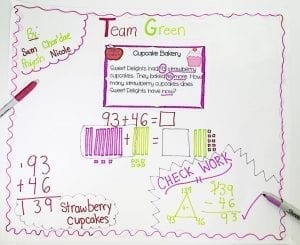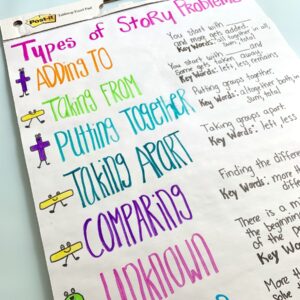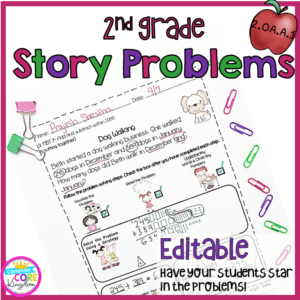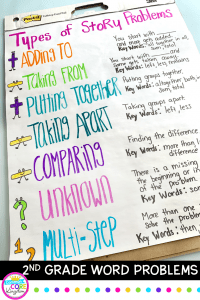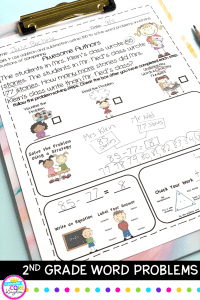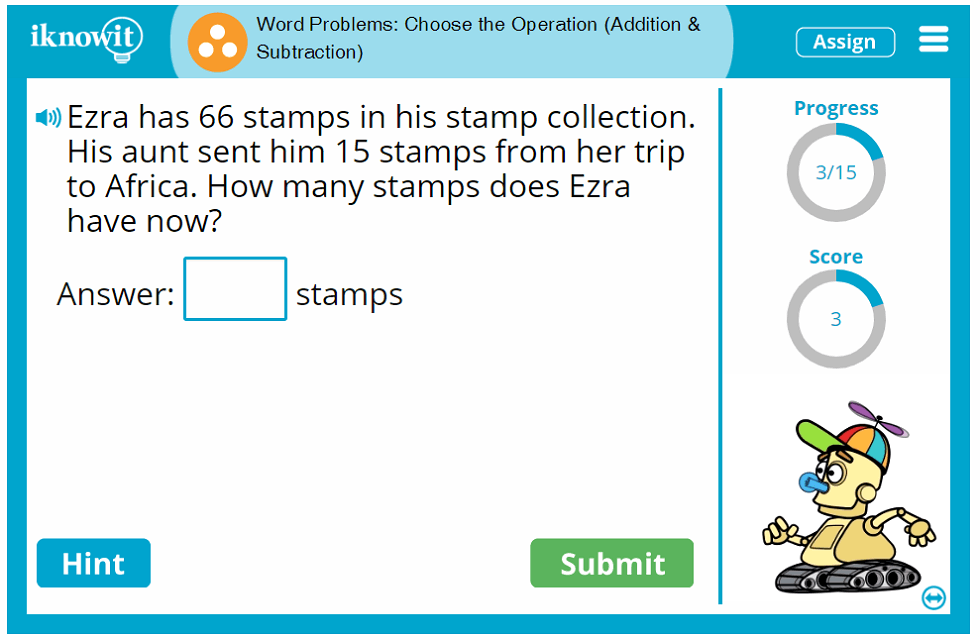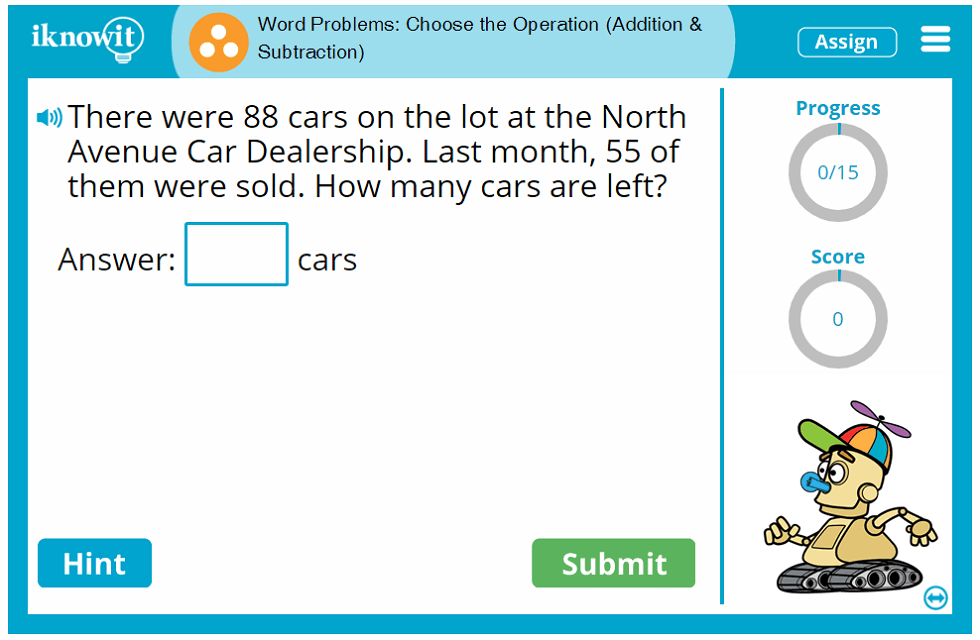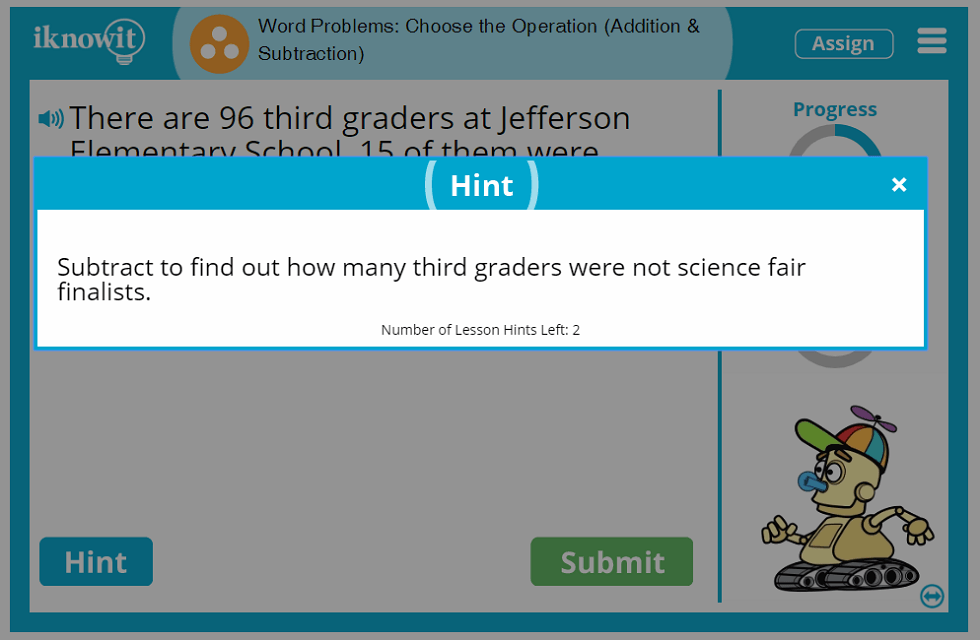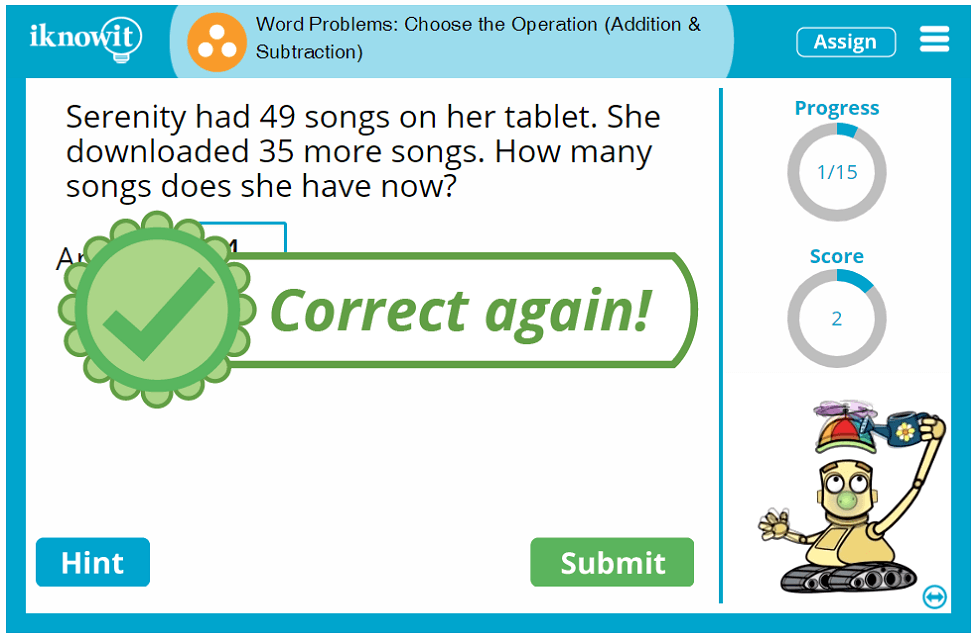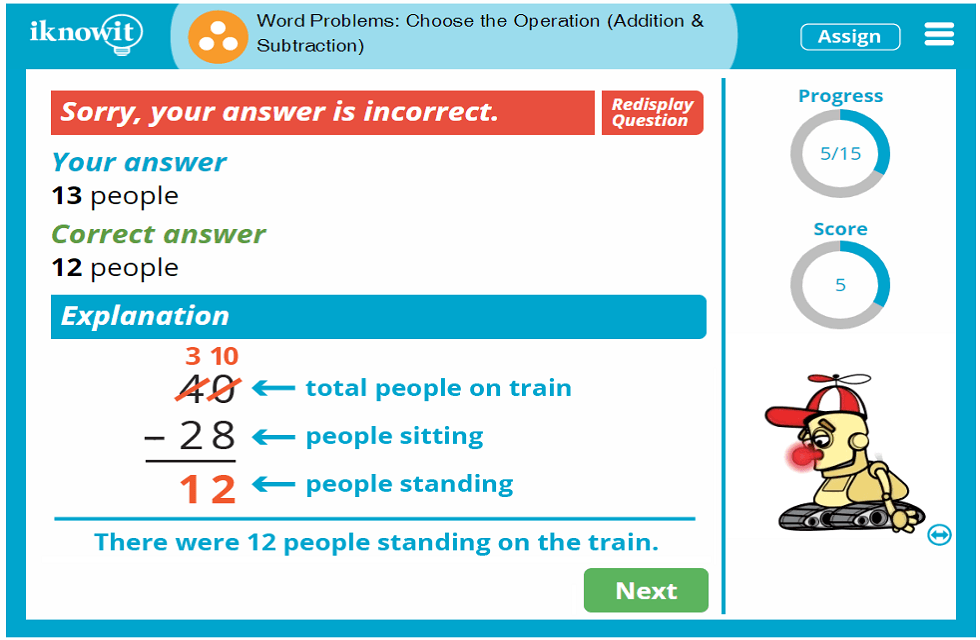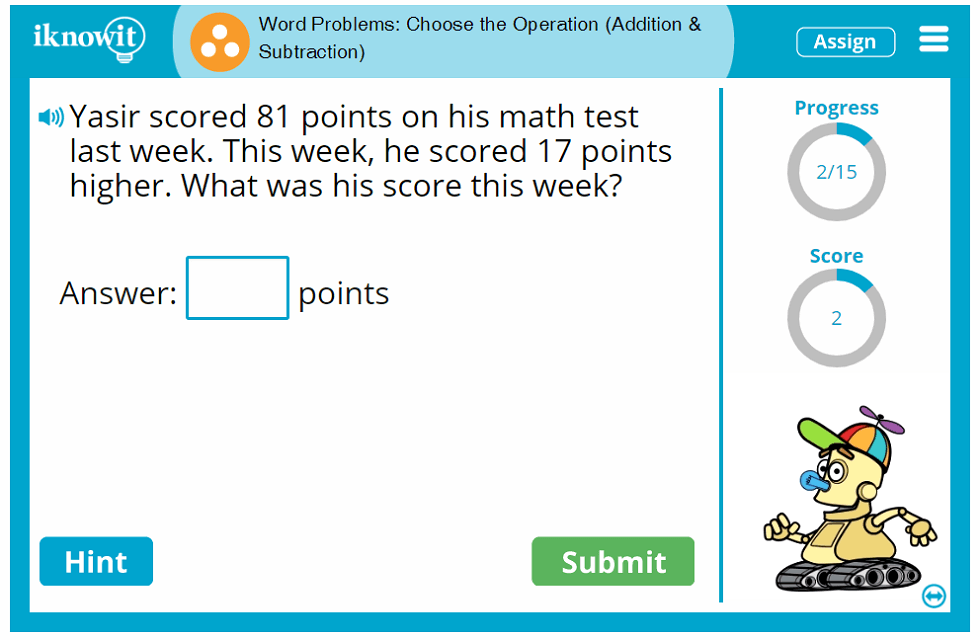Dynamically Created Word Problems
Here is a graphic preview for all of the word problems worksheets. You can select different variables to customize these word problems worksheets for your needs. The word problems worksheets are randomly created and will never repeat so you have an endless supply of quality word problems worksheets to use in the classroom or at home. Our word problems worksheets are free to download, easy to use, and very flexible.
These word problems worksheets are a great resource for children in 3rd Grade, 4th Grade, and 5th Grade.
Click here for a Detailed Description of all the Word Problems Worksheets.
Quick Link for All Word Problems Worksheets
Click the image to be taken to that Word Problems Worksheet.
Words to Symbols
|
Addition Word Problems
|
Addition Word Problems
|
Addition Word Problems
|
Addition Word Problems
|
Addition Word Problems
|
Subtraction Word Problems
|
Subtraction Word Problems
|
Addition and Subtraction
|
Addition and Subtraction
|
Addition and Subtraction
|
Addition and Subtraction
|
Multi-Step Problems
|
Multiplication Word Problems
|
Multiplication Word Problems
|
Multiplication Word Problems
|
Division Word Problems
|
Division Word Problems
|
Division Word Problems
|
Division Word Problems
|
Multiplication and Division
|
Mixed Operations Problems
|
One Step Equation
|
Two Step Equation
|
Multi-Step All Operations
|
Fractions Word Problems
|
Fractions Word Problems
|
Fractions Word Problems
|
Fractions Word Problems
|
Fractions Word Problems
|
U. S. Coins Word Problems
|
Advanced Adding U. S. Coins
|
U. S. Money Word Problems
|
U. S. Money Word Problems
|
U. S. Money Word Problems
|
Travel Time
|
Reading a Calendar
|
Elapsed Dates
|
Ratios and Rate
|
Percentage
|
Mixed Operations
|
U.S. Money
|
Detailed Description for All Word Problems Worksheets
Words to Symbols Handout
This Word Problems Worksheet will produce a great handout to help students learn the symbols for different words and phrases in word problems.
Addition Word Problems Worksheets Using 1 Digit with 2 Addends
These addition word problems worksheets will produce 1 digit problems with two addends, with ten problems per worksheet. These word problems worksheets are appropriate for 3rd Grade, 4th Grade, and 5th Grade.
Addition Word Problems Worksheets Using 2 Digits with 2 Addends
These addition word problems worksheets will produce 2 digits problems with two addends, with ten problems per worksheet. These word problems worksheets are appropriate for 3rd Grade, 4th Grade, and 5th Grade.
Addition Word Problems Worksheets Using 1 Digit with 3 Addends
These addition word problems worksheets will produce 1 digit problems with three addends, with ten problems per worksheet. These word problems worksheets are appropriate for 3rd Grade, 4th Grade, and 5th Grade.
Addition Word Problems Worksheets Using 2 Digits with 3 Addends
These addition word problems worksheets will produce 2 digits problems with three addends, with ten problems per worksheet. These word problems worksheets are appropriate for 3rd Grade, 4th Grade, and 5th Grade.
Addition Word Problems Worksheets 2 Digits Missing Addends
These addition word problems worksheet will produce 2 digits problems with missing addends, with ten problems per worksheet. You may select between regrouping and non-regrouping type of problems. These word problems worksheets are appropriate for 3rd Grade, 4th Grade, and 5th Grade.
Subtraction Word Problems Worksheets Using 1 Digit
These subtraction word problems worksheets will produce 1 digit problems, with ten problems per worksheet. These word problems worksheets are appropriate for 3rd Grade, 4th Grade, and 5th Grade.
Subtraction Word Problems Worksheets Using 2 Digits
These subtraction word problems worksheets will produce 2 digits problems, with ten problems per worksheet. These word problems worksheets are appropriate for 3rd Grade, 4th Grade, and 5th Grade.
Addition and Subtraction Word Problems Worksheets Using 1 Digit
These addition and subtraction word problems worksheets will produce 1 digit problems, with ten problems per worksheet. These word problems worksheets are appropriate for 3rd Grade, 4th Grade, and 5th Grade.
Addition and Subtraction Word Problems Worksheets Using 2 Digits
These addition and subtraction word problems worksheets will produce 2 digits problems, with ten problems per worksheet. These word problems worksheets are appropriate for 3rd Grade, 4th Grade, and 5th Grade.
Addition and Subtraction Word Problems Worksheets 2 Digits With No Regrouping
These addition and subtraction word problems worksheets will produce 2 digits problems with no regrouping and ten problems per worksheet. These word problems worksheets are appropriate for 3rd Grade, 4th Grade, and 5th Grade.
Addition and Subtraction Word Problems Worksheets Using 3 Digits
These addition and subtraction word problems worksheets will produce 3 digits problems, with ten problems per worksheet. These word problems worksheets are appropriate for 3rd Grade, 4th Grade, and 5th Grade.
Multi-Step Problems Addition and Subtraction
These multi-step addition and subtraction word problems worksheets will produce 10 problems per worksheet. These word problems worksheets are appropriate for 3rd Grade, 4th Grade, and 5th Grade.
Multiplication Word Problems Worksheets Using 1 Digit
These multiplication word problems worksheets will produce 1 digit problems, with ten problems per worksheet. These word problems worksheets are appropriate for 3rd Grade, 4th Grade, and 5th Grade.
Multiplication Word Problems Worksheets Using Dozens
These multiplication word problems worksheets will produce problems using dozens, with ten problems per worksheet. These word problems worksheets are appropriate for 3rd Grade, 4th Grade, and 5th Grade.
Multiplication Word Problems Worksheets Using 2 Digits
These multiplication word problems worksheets will produce 2 digits problems, with ten problems per worksheet. These word problems worksheets are appropriate for 3rd Grade, 4th Grade, and 5th Grade.
Division Word Problems Worksheets Using 1 Digit in Divisor
These division word problems worksheets will produce 1 digit divisor problems, with ten problems per worksheet. These word problems worksheets are appropriate for 3rd Grade, 4th Grade, and 5th Grade.
Division Word Problems Worksheets Using Dozens in Divisor
These division word problems worksheets will produce problems using dozens in the divisor, with ten problems per worksheet. These word problems worksheets are appropriate for 3rd Grade, 4th Grade, and 5th Grade.
Division Word Problems Worksheets Using Multiple Digits in Divisor
These division word problems worksheets will produce multiple digits in the divisor for the problems, with ten problems per worksheet. These word problems worksheets are appropriate for 3rd Grade, 4th Grade, and 5th Grade.
Dividing with Fractions Worksheets
These division Word Problems Worksheets will produce problems that focus on division with fractions. You have the option to select the range of denominators, as well as the types of fractions displayed. These word problems worksheets are appropriate for 4th Grade, 5th Grade, and 6th Grade.
Multiplication and Division Problems Using 1 Digit
These multiplication and division word problems worksheets will produce 1 digit problems, with ten problems per worksheet. These word problems worksheets are appropriate for 3rd Grade, 4th Grade, and 5th Grade.
Mixed Operations Word Problems Using 1 or 2 Digits
These mixed operations word problems worksheets will produce addition, multiplication, subtraction and division problems with 1 or 2 digit numbers. These word problems worksheets will produce ten problems per worksheet. These word problems worksheets are appropriate for 3rd Grade, 4th Grade, and 5th Grade.
One Step Equation Word Problems
These equations worksheets will produce one step word problems. These worksheets will produce ten problems per worksheet. These word problems worksheets are a good resource for students in the 5th Grade through the 8th Grade.
Two Step Equation Word Problems
These equations worksheets will produce two step word problems. These worksheets will produce ten problems per worksheet. These word problems worksheets are a good resource for students in the 5th Grade through the 8th Grade.
Multi-Step All Operations Word Problems
These Word Problems worksheets will produce word problems involving all basic operations. You may choose the format of the answers. These word problems worksheets will produce ten problems per worksheet. These word problems worksheets are a good resource for students in the 5th Grade through the 8th Grade.
Adding Two Fractions Word Problems
These fractions word problems worksheets will produce problems with the addition of two fractions. These word problems worksheets will produce ten problems per worksheet. These word problems worksheets are a good resource for students in the 5th Grade through the 8th Grade.
Adding Three Fractions Word Problems
These fractions word problems worksheets will produce problems with the addition of three fractions. These word problems worksheets will produce ten problems per worksheet. These word problems worksheets are a good resource for students in the 5th Grade through the 8th Grade.
Subtracting Fractions Word Problems
These fractions word problems worksheets will produce problems involving subtracting two fractions. These word problems worksheets will produce ten problems per worksheet. These word problems worksheets are a good resource for students in the 5th Grade through the 8th Grade.
Adding Two Mixed Numbers Word Problems
These fractions word problems worksheets will produce problems involving adding two mixed numbers. These word problems worksheets will produce ten problems per worksheet. These word problems worksheets are a good resource for students in the 5th Grade through the 8th Grade.
Subtracting Two Mixed Numbers Word Problems
These fractions word problems worksheets will produce problems involving subtracting two mixed numbers. These word problems worksheets will produce ten problems per worksheet. These word problems worksheets are a good resource for students in the 5th Grade through the 8th Grade.
Adding U.S. Coins Word Problems
This U.S. coins word problems worksheet will produce coin addition problems. These worksheets will produce ten problems per worksheet. These word problems worksheets are a good resource for students in the 5th Grade through the 8th Grade.
Advanced Adding U.S. Coins Word Problems
These Word Problems Worksheets will produce word problems that focus on adding up different denominations of US coin currency. You have the option to select any combination of pennies, nickels, dimes, quarters, and half dollars for each worksheet. These worksheets will produce ten problems per worksheet. These word problems worksheets are a good resource for students in the 5th Grade through the 8th Grade.
U.S. Money Adding Two Items Word Problems
These U.S. money word problems worksheest will produce purchase problems for adding two items. These worksheets will produce ten problems per worksheet. These word problems worksheets are a good resource for students in the 5th Grade through the 8th Grade.
U.S. Money Adding Three Items Word Problems
These U.S. money word problems worksheets will produce purchase problems for adding three items. These worksheets will produce ten problems per worksheet. These word problems worksheets are a good resource for students in the 5th Grade through the 8th Grade.
U.S. Money Change from a Purchase Word Problems
These U.S. money word problems worksheets will produce problems for calculating change from a purchase. These word problems worksheets will produce ten problems per worksheet. These word problems worksheets are a good resource for students in the 5th Grade through the 8th Grade.
Travel Time Word Problems Worksheets
These time word problems worksheets produce problems for finding the duration, start, and end times of trips. Users may select the units of time to use in the problems. These word problems worksheets will produce ten problems per worksheet. These word problems worksheets are appropriate for students in the 5th Grade through the 8th Grade.
Reading a Calendar Word Problems Worksheets
These calendar worksheets will produce word problems revolving around reading and understanding a monthly calendar. You may select the month and the year within a range of the years 1800 to 3999. These word problems worksheets will produce nine problems per worksheet. These word problems worksheets are appropriate for students in the 5th Grade through the 8th Grade.
Elapsed Dates Word Problems Worksheets
These time word problems worksheets will produce questions with elapsed days, weeks, months, and years, with ten problems per worksheet. These word problems worksheets are appropriate for 3rd Grade, 4th Grade, and 5th Grade.
Ratios and Rates Word Problems Worksheets
These ratio word problems worksheets will produce eight ratio and rates word problems for the students to solve. These ratio word problems worksheets are appropriate for 3rd Grade, 4th Grade, 5th Grade, 6th Grade, and 7th Grade.
Percentage Word Problems Worksheets
These Percentage Word Problems Worksheets will produce problems that focus on finding and working with percentages. You have the option to select the types of numbers, as well as the types of problem you want. These percentage word problems worksheets are appropriate for 3rd Grade, 4th Grade, 5th Grade, 6th Grade, and 7th Grade.
Mixed Word Problems with Key Phrases Worksheets
These Word Problems Worksheets will produce addition, multiplication, subtraction and division problems using clear key phrases to give the student a clue as to which type of operation to use. These word problems worksheets are appropriate for 4th Grade, 5th Grade, 6th Grade, and 7th Grade.
U.S. Money Change from a Purchase Multiplication Word Problems
These Word Problems Worksheets will produce problems that ask students to use multiplication to calculate the monetary value of a purchase and then find how much change is given from the purchase.
If you need help figuring out how old someone is (or how old you are) given a birthday, you can use this great Age
Calculator. to answer those questions and many more!
Addition word problems arise in any situations where there is a gain or an increase of something as a result of combining one or more numbers. Think of addition as combining parts to form a whole.
Consider the following situations.
Problem #1:
John has 800 dollars in his checking account. He received from his job a check for 1,200 dollars and deposit the amount in his checking account. How much money does he have in his checking after the deposit?
Solution
The fact of receiving money from his job is a gain. Therefore, we need to perform addition.
Total amount in checking account = 800 + 1200 = 2000 dollars
Problem #2:
Peter sells ice cream for a living. On Monday his revenue was 150 dollars. On Tuesday, his revenue was 100 dollars. Finally, on Wednesday, his revenue was 50 dollars. How much is Peter’s revenue so far?
Solution
Peter is experiencing a gain in revenue. Therefore, we use addition.
Peter’s revenue = 150 + 50 + 100 = 300 dollars
Problem #3:
Eiffel Tower is about 1063 feet high. The Statue of Liberty along with its foundation and pedestal is about 305 feet. If you could put the Statue of Liberty on top of the Eiffel Tower, how high up in heaven will the two monuments reach?
Solution
The situation above is a combination of parts to form a whole. Therefore, we use addition.
Problem #4:
Ana found a 15 dollar bill on the floor on Saturday.
Then on Sunday her parents gave her 155 dollars.
How much does Ana have all together?
CLUE:
Saturday~15 dollars
Sunday~155 dollars
Solution:
15+155 = 170 dollars all together
Have A Great Basic Math Word Problem?
Share it here with a very detailed solution!
What Other Visitors Have Said
Click below to see contributions from other visitors to this page…
Mom. How many pens and pencils?
Mr. Bower has 3 times as many pens as pencils. He has 20 pens and pencils altogether. How many pens does he have?
Solve by trial and error:
Say …
Number trick that always equals 5
1. Think of any positive whole number. No fractions, no decimals, and no percents.
2. Double that number.
3. Add 10 to that result in step 2. …
How to Find the Cost to Rent Bikes Not rated yet
The cost to rent a bike for 1 person under age five is 3£ and 5.50£ for anybody over age five. Calculate the cost to rent 7 bikes if 4 people are under …
Max and Mary’s Picnic Not rated yet
Max and Mary are going on a picnic. Mary packs 4 apples, 3 oranges and 2 bananas. Max packs 2 more apples than marry and 8 more oranges than Mary. If Max …
Click here to write your own.
Recent Articles
-
30-60-90 Triangle
Apr 03, 23 05:08 PM
What is a 30-60-90 triangle? Definition, proof, area, and easy to follow real-world examples.
Read More
-
Calculate the Conditional Probability using a Contingency Table
Mar 29, 23 10:19 AM
Learn to calculate the conditional probability using a contingency table. This contingency table can help you understand quickly and painlessly.
Read More
Teaching Word Problems
Word problems was one of the biggest units I taught in 2nd grade, and I know firsthand that teaching word problems to 2nd graders can be challenging. But as challenging as it can be, it is also extremely important. Word problems are a key skill for students and should be taught and reviewed throughout the entire year.
Before we talk about teaching 2nd grade word problems, let’s look at where students should be when they enter 2nd grade and how to handle below level students.
What First Graders Should Know
Students entering the 2nd grade should have the following skills:
- Solve word problems up to 20 using addition and subtraction;
- Types of word problems: adding to, taking from, putting together, taking apart, and comparing with unknowns in all positions.
At the beginning of the year, it’s beneficial to evaluate students’ understanding of adding and subtracting to 20. If they can add and subtract to 20 fluently, then move on to numbers 20-50. If there are a large group of students who still struggle, take some time to review the 1st-grade word problem standard 1.OA.A.1.
Use addition and subtraction within 20 to solve word problems involving situations of adding to, taking from, putting together, taking apart, and comparing, with unknowns in all positions.
The only difference between the 1st and 2nd grade standards is that 1st grade solves up to 20, while 2nd grade solves up to 100. So if you do need to review 1st grade standards, you’re still covering the practical concepts of the standard, just within a limited number range.
How much time you spend on review will depend on the levels of your students. If your students need it, it is helpful to allocate the entire first cycle of teaching word problems to review, which would put this at about two weeks. That may seem like a lot of time to review, but keep in mind that during this time you are teaching students about the different types of word problems and the problem-solving process. Working with numbers under 20 makes the computation more manageable and allows students to focus on learning the types of problems and the problem-solving process.
Teaching 2nd Grade Word Problems: Day 1
Preparing for the Lesson:
- Create a poster to model a word problem. You can use my poster word problems from my 2nd Grade Word Problem packet, or you can write your own.
- Print and laminate the Problem-Solving Process posters. Attach them to a ribbon and hang them in a convenient place where all students can see them. Make sure you can easily access the poster or move it for the lessons.
- Begin creating a “Types of Word Problems” poster. For day 1, you should include “Adding To” word problems. You will add skills to this poster as you introduce them to the students.
- Prepare one group word problem posters for each group for the students to use during group work. You can write your own problems or print one of the “adding to” poster problems in my word problem packet. A great way to engage your students is to write word problems with their names. I’ve also made my word problem packet editable, so you can type your class list and the problems will autogenerate with your class list!
Opening the Lesson:
1) Introduce the Standard
Introduce the standard. Tell students that you are starting by reviewing word problems they learned in first grade. Today students will work on “Adding to” word problems. “Adding to” problems mean you start with a number of something, and more gets added to your group.
2) Introduce the Problem
Show the word problem poster. Explain that you are going to show them how to solve this problem.
- Show the problem-solving process poster. Point to the first step. Explain that first, we need to read the problem and visualize it. Then model the skill by reading the problem and then explaining the picture you see in your mind.
- “Sweet Delights had 33 strawberry cupcakes. They baked 6 more. How many strawberry cupcakes does Sweet Delights have now?”
- I am imagining a cupcake shop with trays of cupcakes on the counter. They have a tray with 33 cupcakes, which is 3 rows of 10 and 1 row of 3. Next, I am imagining the baker coming out with 6 more strawberry cupcakes and adding them to the row of 3.
- Now I have visualized the problem (point to the first step on the process chart).
3) Retell for Comprehension
Next, I am going to retell the problem.
- Cover up the problem with your hands and retell the story to your class. Ask, “Did I get the gist of the problem?”
4) Identify Key Words
Now that I have retold the problem, I know I comprehend it, so I am ready to circle and underline key words. Model circling the numbers in the problem and underlining the key words.
- “Sweet Delights had (33) strawberry cupcakes. They baked (6) more. How many strawberry cupcakes does Sweet Delights have now?”
- Check! I have circled and underlined the key words and numbers that will help me solve the problem.
5) Solving Strategy
Next, I am going to solve the problem using a strategy. For this problem, I am going to draw a picture.
- Draw a cupcake tray with 3 rows of ten circles and one row of 3 circles using a black marker.
- “I have the 33 cupcakes Sweet Delights started off with. Now, I am going to add 6 more.” Draw 6 pink circles on the tray.
- Now I have all of the strawberry cupcakes, so to answer the question “How many strawberry cupcakes does Sweet Delights have now?” I am going to count all of the cupcakes. I have 39 cupcakes.
*Note* In the beginning of 2nd grade, drawing pictures and diagrams to solve problems is an appropriate method for solving problems. As students learn the problem-solving process, numbers will get more difficult and students should move to more efficient strategies.
6) Write Equation
Now that I have solved the problem, I am going to write an equation.
- This was an “adding to” problem, so I know this is an addition equation.
______ + _______ = ________
- Sweet Delights started with 33 strawberry cupcakes, so I know that is going to be the first number in my equation.
- Then, they added 6 more strawberry cupcakes, so I know that is going to be my second number.
- I know that after they added 6 cupcakes, they had a total of 39 strawberry cupcakes, so 39 is what comes after the equal sign.
7) Label Answer
The next step says to label my answer.
- What does 39 mean? Are there 39 puppies? Or 39 children? Maybe 39 pencils? No, it means 39 strawberry cupcakes.
 Check Work
Check Work
Now that I have my answer, you probably think I’m done, right? No! Math is awesome because we know there is often a right or wrong answer. There are lots of chances for making mistakes, but if we check our work, we will be much more confident we didn’t make a mistake.
- Model how to check your work by using a different strategy. The strategy could be using manipulatives, doing another picture, or counting on your fingers. After you’ve modeled checking your work, put a big check next to the answer to show this step is complete.
Group Work:
Now students will have a chance to try the problem-solving steps with an “adding to” problem in their groups. They will make their own poster with their groups showing all of their work. Students love to work on chart paper or large construction paper.
(Note: It is important to set expectations for group work, including all students participate and help each other. When the teacher comes over to ask a question, all group members should be able to answer.)
As each group works on their problem, rotate to ask questions to check for understanding. If students make mistakes, don’t tell them directly. Instead, expect students to “catch it” when they check their work. After students have completed all of the steps, review their poster and allow them to go over their work in markers, so it stands out. Then, I select one group to share with the class how they solved the problem.
Independent Work:
Next, students work independently on one of the 2nd grade word problems from my word problem packet. Pull students who are struggling into quick one on ones. Reteaching in small groups can also be effective, but it is usually sufficient to have students work independently while you monitor and ask questions to guide them in the right direction. Don’t forget that the goal is to get them to be more independent!
Right before the end of the work period, walk around the room one more time to observe students working. Select one student who has followed the steps and gotten the correct answer to share how they solved the problem. (Note: At the beginning of the unit I liked to purposefully select students who “get it”, but as the unit progresses, I think it is important to have students share who may have skipped a step or gotten the wrong answer.
At the beginning of this unit, I would only give students 1-2 problems to practice each day. This is of the utmost importance. Less is more because the goal is to get students to master the problem-solving process. Giving students too many problems early on can overwhelm their learning process and put too much focus on getting answers just to get it done.
Closing:
Start by collecting all independent work. Then have the selected student share how they solved the problem. Initially, it is important to have the student share the whole process, but as the unit and year continue and students have mastered the process, you can shorten this by having a student share one step they did.
To ensure students have mastered the problem solving strategy, I always gave a short quiz on the last day or before beginning the next strategy. My word problem packet also includes short, 2 question quizzes so ensure your students are on track.
Building on Word Problem Skills:
Continue this routine each day, going through a different type of story problem. Here is a sample schedule:
| Day 1 | Adding To |
| Day 2 | Taking From |
| Day 3 | Putting Together |
| Day 4 | Taking Apart |
| Day 5 & 6 | Comparing |
| Day 7 & 8 | Unknown |
| Day 9 & 10 | Multistep |
| Day 12 & 13 | Review All Types |
Adding to, taking from, putting together, and taking apart problems tend to be easier for students to grasp, because they have the most exposure to these. Comparing, unknown, and multistep problems are much more challenging, so you may need a few days to focus on these.
After teaching all of the typse of problems, I assess students on 2.OA.A.1 with the number range I taught. You can find assessments for 20-50, 50-100, and 100-1,000 in word problem packet.
The Big Picture:
While teaching 2nd grade word problems throughout the year, use this same process to build on student’s problem-solving skills.
When students are learning to add and subtract to 100, do another unit on problem-solving with numbers to 100. When students are learning to add and subtract to 1,000, you can expand on the skills and do a problem-solving unit with numbers to 1,000, despite the standard only going to 100.
Other thoughts
- While teaching 2nd grade word problems, I place a strong emphasis on the problem-solving process. As students begin to understand the steps and develop their problem solving skills, it is important to give them flexibility. Everyone’s brain works differently, and we may do some steps in a different order. For example, it may make more sense for some students to write their equation before they solve the problem, but others may need to work the problem out first. Some students may circle key words while they read the problem because this helps them comprehend. Remember to remain flexible with students and don’t be afraid to suggest different approaches to help them grasp the concepts.
Interactive Math Lesson – Word Problems: Choose the Operation
Give your students extra practice with addition and subtraction word problems! This third grade-level math lesson will help children become more confident and proficient at solving word problems. By the time students are finished working through this lesson, they will be skilled at solving a variety of addition word problems and subtraction word problems.
Students will determine whether they need to add or subtract the numbers presented in their word problems. Here is an example of questions children may be asked in this third grade math activity: «There were 55 people on the subway heading uptown. At the 42nd street stop, 13 more people got on. How many people are on the subway now?» Another example, «61 people signed up for the pottery class at the City Recreation Center. 59 people showed up to class. How many people missed the class?» A third example, «There were 88 cars on the lot at the North Avenue Car Dealership. Last month, 55 of them were sold. How many cars are left?» Word problems include addition questions and subtraction questions.
If students need a little extra help, they can click on the «Hint» button to be shown a relevant written or pictorial clue. For example, in the last example above, the hint would say: «Subtract to find out how many cars are left.» When students answer a question incorrectly, a detailed explanation page shows them exactly where they went wrong, so they can learn from their mistakes as they move through the lesson.
More «I Know It» Features
Educators, parents, and students alike enjoy using the I Know It math program alongside their elementary math curriculum for extra math practice. Teachers and parents appreciate the scope and variety of our expanding collection of math lessons. Students enjoy practicing math in an engaging, interactive format. Whimsical animated characters, positive feedback, and fun math awards give students the right dose of fun added into their math practice. It’s a great program for everyone!
Here are some additional lesson features that help students make the most of their math practice time. A progress-tracker in the upper-right corner of the practice screen allows students to see how many questions they have answered so far in the lessons, and a score-tracker beneath that shows them how many questions they have answered correctly. A speaker icon indicates the read-aloud feature; students can click it to have the question read to them in a clear voice. (What a great option for ESL/ELL students or for students who prefer auditory learning.)
We hope you will try out this interactive math lesson featuring addition and subtraction word problems with your class! Be sure to explore the hundreds of other math topics we have available on iKnowIt.com!
Free Trial and Membership Options
Sign up for your free sixty-day trial today and try out this math lesson with your students! Your class can play any math game on our website in the free trial mode. We’re confident you and they will love it! Once your free trial expires, be sure to sign up for an I Know It membership. We have membership options for families, single teachers, and schools.
Your I Know It membership includes handy administrative features, which allow you to create a class roster and add your students to it; track and monitor your students’ progress; give your students each a unique user name and password; print, email, and download your students’ progress reports; change lesson settings; and much more!
We’re confident you and your students will love iKnowIt.com! Contact us with any questions and get started with your membership today!
Level
This online math lesson is classified as Level C. It may be appropriate for a third grade class.
Common Core Standard
3.OA.8
Operations and Algebraic Thinking
Students should demonstrate an ability to solve problems involving the four operations and identify and explain patterns in arithmetic.
You might also be interested in…
Multiplying 2-Digit by 1-Digit Numbers (Level C)
In this third grade-level math lesson, students will practice multiplying 2-digit by 1-digit numbers. Questions are presented in vertical multiplication, horizontal multiplication, and multiplication word problem formats.
Associative Property (Multiplication) (Level C)
In this math lesson geared toward third grade, students will practice the associative property of multiplication by filling in the missing factor.
Different Types of Addition and Subtraction Situations
In our day to day situations, we come across different problems that relate to addition and subtraction in mathematics. For instance, if you buy a few items from a grocery store, you will need to check the bill raised by the store by adding the costs of the items purchased. Similarly, there might be a situation when you need to find the difference between the original and the discounted price of an item. Such situations make it necessary for students to have a strong grasp of the understanding of the concepts of addition and subtraction. However, this cannot be achieved without enough practice.
Important Terms and Keywords in addition and subtraction
Below are some important terms and keywords that are associated with addition and subtraction –
| how many | how much | leftover | still to go |
| additional | together | combined | add |
| both | sum | increase | difference |
| total | change | more | decrease |
| fewer | spent | reduce | remaining |
| less |
Let us discuss some such situations which can be useful in the understanding of these terms.
Situations where we use the term “Add To”
Below are some situational problems where we make use of the term “ Add To ”–
- There are three fishes in a pond. Four more fish are added to the pond. How many fishes are there in the pond now?
We have been given –
Number of fishes in the pond = 3
Number of more fishes added to the pond = 4
For obtaining the total number of fishes in the pond now, we will have to add the number of fishes added to the pond to the number of fishes that were present in the pond earlier. Therefore,
3 + 4 = 7 this is the total number of fishes in the pond now
- There are 2 tigers in a forest. Five more tigers are brought from the nearby forest. How many tigers are there in the forest now?
We have been given –
Number of tigers in the forest = 2
Number of more tigers brought in from nearby forest = 5
For obtaining the total number of tigers in the forest now, we will have to add the number of tigers brought in from the nearby forest to the number of tigers that were present in the forest earlier. Therefore,
2 + 5 = 7 this is the total number of tigers in the forest now
Situations where we use the term “Put Together”
We could have used the term put together as well in the above questions. For instance, the question in the example above could be rephrased as –
- There are three fishes in a pond. Four more fish are added to the pond. How many fishes are there in the pond put together?
Similarly, the second question could also be rephrased as –
- There are 2 tigers in a forest. Five more tigers are brought from the nearby forest. How many tigers are there in the forest put together?
Situations where we use the term “Take From”
Below are some situational problems where we make use of the term “Take From”–
- On his birthday, James placed 12 burning candles on the cake. He blew nine of them. How many of the candles were burning on the cake now?
We have been given –
Number of candles burning on the cake = 12
Number of candles blown by James = 9
For obtaining the total number of candles burning on the cake now, we will have to take the number of candles left burning on the cake from the number of candles that were burning on the cake earlier. Therefore,
12 – 9 = 3 this is the total number of candles left burning on the cake
- There were 16 mangoes on a tree. Samuel plucked 9 of them. How many mangoes were left on the tree?
We have been given –
Number of mangoes on a tree = 15
Number of mangoes plucked by Samuel = 9
For obtaining the total number of mangoes left on the tree now, we will have to take the number of mangoes plucked by Samuel from the number of mangoes on a tree earlier. Therefore,
15 – 9 = 6 this is the total number of mangoes left on the tree now
Situations where we use the term “Compare”
Below are some situational problems where we make use of the term “Compare”–
- Jack scored 25 marks in a test while Peter scored 38 marks in the same test. How many more marks did Peter score as compared to Jack?
We have been given –
Marks scored by Jack in a test= 25
Marks scored by Peter in the same test = 38
For obtaining additional marks scored by Peter, we shall compare his marks with that of Jack. We will have,
25 + ________ = 38
= 13
Hence, Peter scored 13 more marks as compared to Jack.
- Michael has 13 playing cards while Alice has 22 playing cards. How many more playing cards does Alice have as compared to Michael?
We have been given –
Number of cards that Michael has = 13
Number of cards that Alice has = 22
For obtaining additional cards that Alice has as compared to Michael, we shall compare the number of cards that Alice has with that of Michael. We will have,
13 + ________ = 22
= 9
Hence, Alice has 9 more cards as compared to Michael.
Does more always mean to add?
It is usually assumed that the term “ more “ means to add. However, that is not the case. At times, when we ask questions such as “ How much more is A than B “, this means that we need to find the difference between A and B or in other words subtract them.
Common Errors
There are some common mistakes when it comes to solving word problems on addition and subtraction. Some of these are –
- Calculation errors – You need to be extremely careful when adding or subtracting numbers as often it is seen that students make mistakes when working in a careless manner.
- Proper explanation – When it comes to working on word problems, it is important to mention proper statements so as to explain the steps undertaken correctly. These include mentioning what is given, what needs to be calculated and the formula intended to be used for this purpose.
- Understanding of the Problem – One of the most common errors is when a student fails to identify whether the problem needs a solution through addition or subtraction.
Addition and Subtraction Word problems Involving Money
We know that money is available in different forms at different places. For buying things we use coins and notes which are issued by the respective governments of the country we live in. These are called currency. Let us discuss some money-related situations where we make use of addition or subtraction
Example
Suppose, Gracia purchased two items, one at the cost of £ 2.05 while another at the cost of £ 4.20. What is the total cost she needs to pay altogether?
Solution
We have been that given that Gracia purchased two items, one at the cost of £ 2.05 while another at the cost of £ 4.20. We need to find out how much Gracia needs to pay altogether. There are two ways of doing it. Either we add the money directly or first convert the given amounts in pence. We know that
£ 1 = 100 p
Therefore, we have,
£ 2.05 = 2.05 x 100 = 205 p
£ 4.20 = 4.20 x 100 = 420 p
Now we have two values 205 p and 420 p. we can add these values, in the same manner, we add two whole numbers. We will get,
205 p + 420 p = 625 p
Now we have obtained our result in pence. To convert it back into pounds, we will have to divide the result by 100. We will now have,
625 p = £ $frac{625}{100}$ = £ 6.25
Hence, we can say that the sum of £ 2.05 and £ 4.20 = £ 6.25
A direct way of solving this problem would have been to add the two amounts directly. We would then have,

It is important to note here that irrespective of the method we use, we shall get the same result.
Let us consider another example.
Example
Maria purchased a syrup for £ 36.00, a cookies box for £ 29.50 and a hair oil bottle for £ 32.50. If she gave the shopkeeper £ 100, how much money did the shopkeeper return as balance?
Solution
We have been given that Maria purchased a syrup for £ 36.00, a cookies box for £ 29.50 and a hair oil bottle for £ 32.50. She gave the shopkeeper £ 100. We are required to find the money returned by the shopkeeper as a balance. In order to do so, first, let us summarise the items purchased by Maria.
Cost of syrup purchased by Maria = £ 36.00
Cost of cookies box purchased by Maria = £ 29.50
Cost of hair oil bottle purchased by Maria = £ 32.50
Total shopping by Maria = £ 36.00 + £ 29.50 + £ 32.50 = £ 98
Now, Maria gave £ 100 to the shopkeeper. Therefore
Change returned by the shopkeeper = £ 100 – £ 98 = £ 2.00 Change returned by the shopkeeper = £ 100 – £ 98 = £ 2.00
Hence, Maria got £ 2.00 from the shopkeeper as a change.
Addition and Subtraction Word problems Involving Decimals
We perform addition and subtraction of decimals in many situations in our day-to-day lives. For example, you may need to add up your grocery bill before paying at the counter. Have you ever noticed that most of the prices are in decimals? Let us discuss through an example where we use addition or subtraction of decimals in our daily life.
Example
Sophie had £ 305.80 in her bank account. She deposited £ 250.25 more and then withdrew £ 317.50 from her account. What is the balance now in her account?
Solution
Let us first define what is given and what needs to be calculated. We have been given that Sophie had £ 305.80 in her bank account. She deposited £ 250.25 more and then withdrew £ 317.50 from her account. We are required to find the balance in her account now. Therefore,
Initial amount in Sophie’s account = £ 305.80 …………………. ( 1 )
The amount deposited by Sophie = £ 250.25 …………………. ( 2 )
Both the decimal numbers are like terms; hence we can go ahead with the calculations.
Total amount in Sophie’s account = ( 1 ) + ( 2 )
= £ 305.80 + £ 250.25
= £ 556.05 …………………………… ( 3 )
Now, from this total amount, Sophie had withdrawn £ 317.50
Therefore, money left in her account = ( 3 ) – £ 317.50
Again, both the decimal numbers are like terms; hence we can go ahead with the calculations.
= £ 556.05 – £ 317.50
= £ 238.55
Hence, money left in Sophie’s account = £ 238.55
Let us take another example.
Example
Sam, Peter and Henry bought 8.5 litres, 7.25 litres and 9.4 litres of milk respectively from a milk booth. How much milk did they buy in all? If there were 30 litres of milk in both, find the quantity of milk left.
Solution
Let us first define what is given and what needs to be calculated. We have been given that Sam, Peter and Henry bought 8.5 litres, 7.25 litres and 9.4 litres milk respectively from a milk booth. We need to find out –
a) How much milk did they buy in all?
b) If there were 30 litres of milk in both, find the quantity of milk left.
Let us find the answers to the above problems one by one.
Amount of milk bought by Sam = 8.5 litres
Amount of milk bought by Peter = 7.25 litres
Amount of milk bought by Henry = 9.4 litres
The total amount of milk bought by them = 8.5 litres + 7.25 litres + 9.4 litres
Note here that the given decimals are not like terms. Hence, we will first need them to be converted into like terms. Therefore, we now have,
Amount of milk bought by Sam = 8.5 litres = 8.50 litres
Amount of milk bought by Peter = 7.25 litres = 7.25 litres
Amount of milk bought by Henry = 9.4 litres = 9.40 litres
Now that the terms are like terms, we can go ahead with the calculations.
Total milk bought by Sam, Peter and Henry = 8.50 litres + 7.25 litres + 9.40 litres = 25.15 litres
Hence, the total milk bought by Sam, Peter and Henry =25.15 litres
Now, let us solve the second part of the question. We have been given that there were 30 litres of milk in the booth. How much milk is left after Sam, Peter and Henry bought the milk?
Therefore,
Total milk in booth = 30 litres
Milk bought by Sam, Peter and Henry = 25.15 litres
Again, we can see here that the given decimals are not like terms. Hence, we will first need them to be converted into like terms. Therefore, we now have,
Total milk in booth = 30 litres = 30.00 litres
Milk bought by Sam, Peter and Henry = 25.15 litres
Now that the terms are like terms, we can go ahead with the calculations.
Milk left in the booth = 30.00 litres – 25.15 litres
= 4.85 litres
Hence, after Sam, Peter and Henry, 4.85 litres of milk was left in the booth.
Addition and Subtraction Word problems Involving Fractions
It is not just money or decimals, we find everyday situations where we need to solve word problems involving addition and subtraction. We are required to do so in the case of fractions as well. Let us look at some situations where we encounter addition and subtraction word problems involving fractions –
Example
A recipe needs 3/7 teaspoon black pepper and 1/4 teaspoon red pepper. How much more black pepper does the recipe need?
Solution
We have been given that a recipe needs 3/7 teaspoon black pepper and 1/4 teaspoon red pepper. We need to find out how much more black pepper is required in the recipe as compared to red pepper.
First of all, we will summarise the fractions given to us. We have,
Fraction of black pepper needed in the recipe = $frac{3}{7}$
Fraction of red pepper needed in the recipe = $frac{1}{4}$
In order to find out how much more black pepper is required in the recipe as compared to red pepper, we will need to find the difference between the black pepper and the red pepper used.
Therefore, we need to find out the value of $frac{3}{7} – frac{1}{4}$
The denominators of the above fractions are different; therefore, we will find their L.C.M first.
L.C.M of 7 and 4 = 28
Now, we will convert the given fractions into equivalent fractions with denominator 28.
$frac{3}{7} = frac{3 x 4}{7 x 4} = frac{12}{28}$
$frac{1}{4} = frac{1 x 7}{4 x 7} = frac{7}{28}$
Now, that the denominator of both the fractions is the same we will find the difference in their numerators. We have,
$frac{3}{7} – frac{1}{4} = frac{12}{28} – frac{7}{28} = frac{12- 7}{28} = frac{5}{28}$
Hence, the amount of more black pepper required in the recipe as compared to red pepper = $frac{5}{28}$
Recommended Worksheets
Fact Families for Addition and Subtraction (Christmas Themed) Math Worksheets
Problem Solving – Addition and Subtraction (World Teachers’ Day Themed) Math Worksheets
Solving Word Problems involving Addition and Subtraction of numbers within 120 1st Grade Math Worksheets
We spend a lot of time researching and compiling the information on this site. If you find this useful in your research, please use the tool below to properly link to or reference Helping with Math as the source. We appreciate your support!



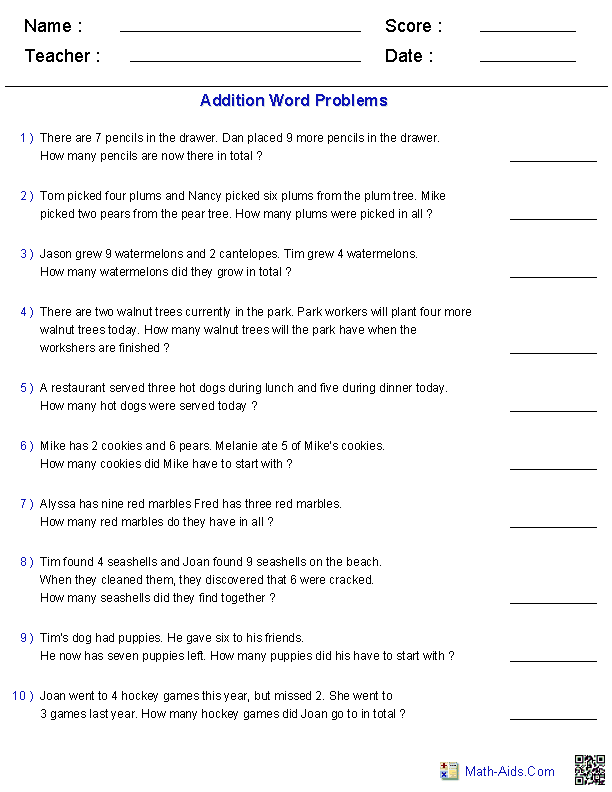







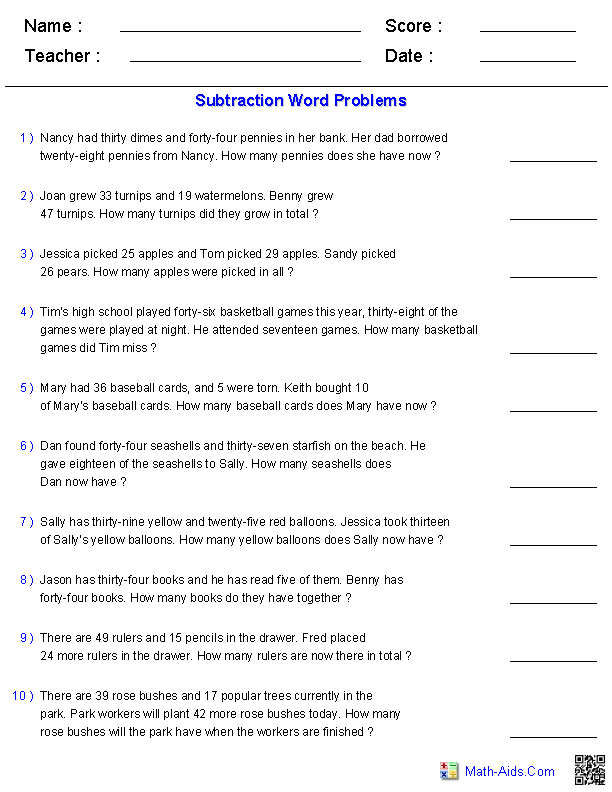

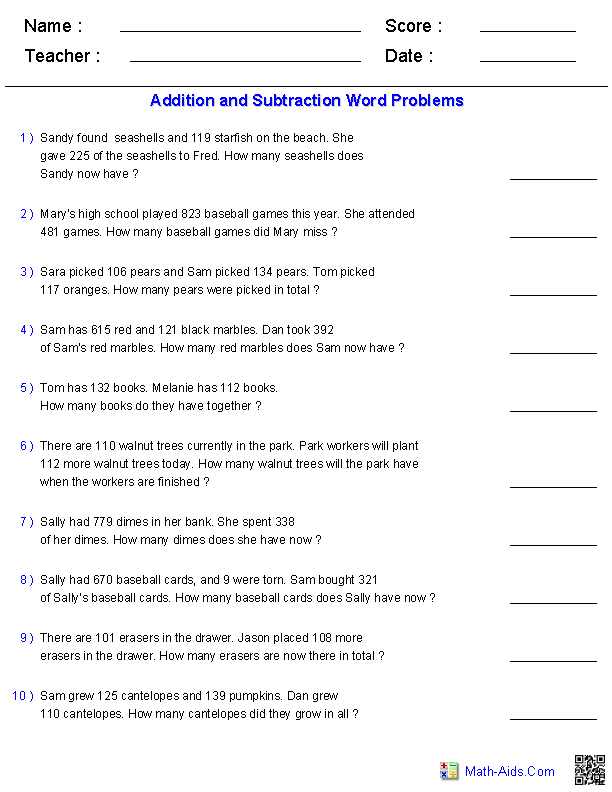











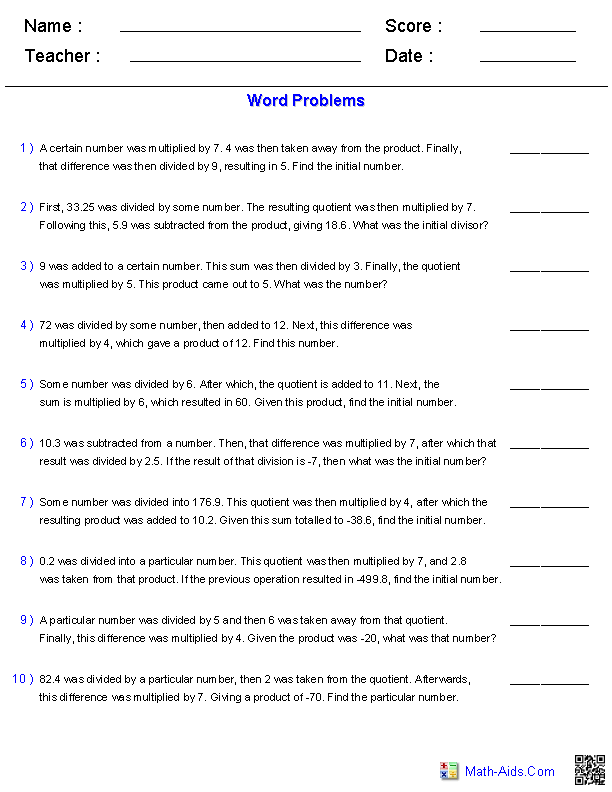










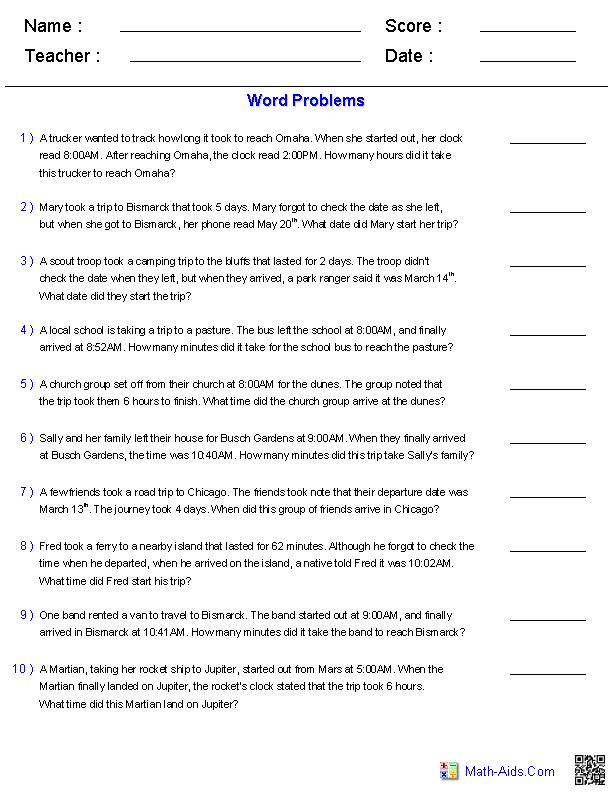
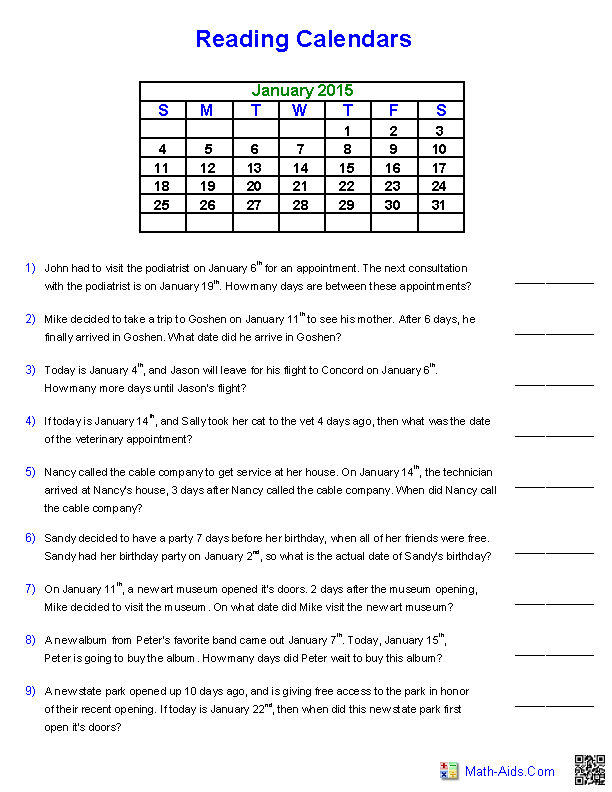








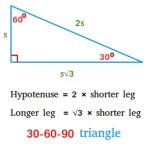
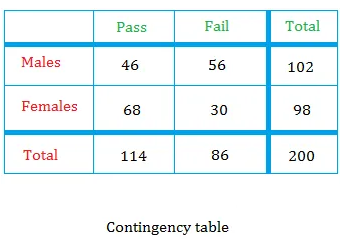
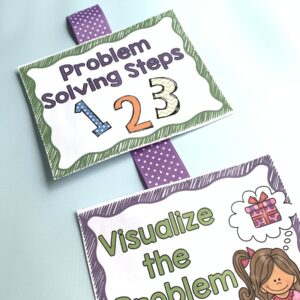
 Check Work
Check Work